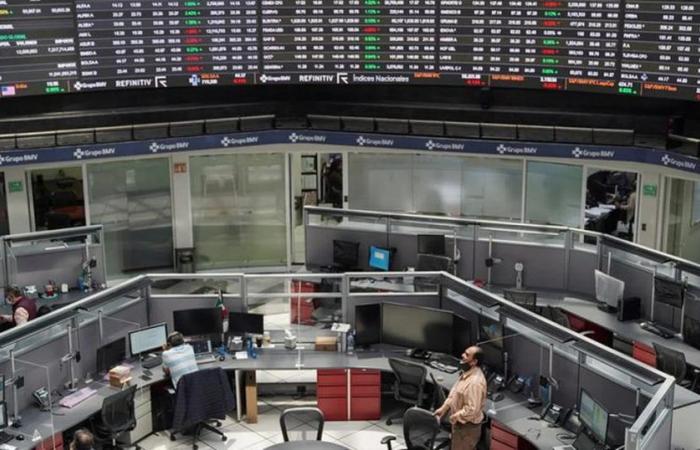The Mexican stock exchange (BMV) broke the negative streak with which it ended yesterday and started the day with significant gains. The main benchmark index of the BMV recovered almost half a percentage point during the first hours of this Friday.
The Mexican S&P/BMV IPC index began the day with a gain of 0.40% to 52,521.47 points.
In relation to the last seven days, the Mexican index records a drop of 0.37%%so in year-on-year terms it still maintains a decrease of 1.56%.
The S&P/BMV IPC is at a 10.89% below its maximum of this year (58,711.87 points) and a 0.98% above its lowest rating for the current year (51,807.55 points).
A stock index It is an indicator that shows how the value of a set of assets evolves.for which it collects data from several companies or sectors of a part of the market.
These indicators are mainly used by the stock exchanges of each country and each of them can be integrated by firms with certain characteristics such as having a similar market capitalization or belonging to the same type of industry. Likewise, there are some indexes that only take into account a handful of stocks to determine their value or others that consider hundreds of stocks.
Stock indices serve as indicator of stock market confidence, business confidence, health of the national and global economy, and stock investment performance and shares of a company. Generally, if investors do not have confidence, stock prices would tend to fall.
Likewise, they function to measure the performance of an asset manager and allow investors to compare profitability and risk, measure the opportunities of a financial asset or create portfolios.
This type of indicators began to be used at the end of the 19th century after the journalist Charles H. Dow. He carefully investigated how company stocks tended to rise and fall in price together, so he created two indexes: one containing the 20 largest railroad companies (since it was the most important industry at the time), as well as 12 stocks from other types of businesses.
Today in humanity there are various indexes and They can be grouped based on their location, sectors, company size or even the type of asset.For example, the American Nasdaq index is made up of the 100 largest companies mostly related to technology such as Apple (AAPL), Microsoft (MSFT), Amazon (AMZN), Facebook (FB), Alphabet (GOOG), Tesla (TSLA), Nvidia (NVDA), PayPal (PYPL), Comcast (CMCSA), Adobe (ADBE).
Each stock index has its own calculation method.but the main factor is the market capitalization of each company that makes up the bond. This is obtained by multiplying the value of the bond on the corresponding stock exchange by the total number of shares on the market.
Companies listed on the stock exchange are required to present a balance of its composition. This report must be submitted every three or six months, as the case may be.
Reading a stock index also involves observing its variations over time. New indices always start with a fixed value based on security prices on your start date, but not everyone follows this method. Therefore, it may seem misleading.
If one index gains 500 points in a day, while another only adds 20, it might seem that the former performed better. But if the former started the day at 30,000 points and the other at 300, it can be concluded that, in percentage terms, the gains for the latter were more notable.
Between the Major US stock market indices There is the Dow Jones Industrial Average, better known as Dow Jones, made up of 30 companies. Likewise, the S&P 500which includes 500 of the largest companies on the New York Stock Exchange. Finally, there is the Nasdaq 100which unites 100 of the largest non-financial firms.
On the other hand, the most important indices of Europe are the Eurostoxx 50, which covers the 50 most important companies in the eurozone. Furthermore, the DAX 30, the main German index that contains the most prominent companies on the Frankfurt Stock Exchange; the FTSE 100 from the London Stock Exchange; he CAC 40 from the Paris Stock Exchange; and the IBEX 35from the Spanish stock market.
In Asiathe main stock market indices are the Nikkei 225made up of the 225 largest companies on the Tokyo Stock Exchange. Also, the SSE Composite Indexis seen as the most representative of China, made up of the most relevant companies of the Shanghai Stock Exchange. Likewise, it is worth mentioning the Hang Seung Index in Hong Kong and the KOSPI in South Korea.
Talking about the Latin American regionyou have the CPIwhich contains the 35 most influential firms on the Mexican Stock Exchange (BMV). At least a third of them belong to the capital of magnate Carlos Slim.
Another is the Bovespacomposed of the 50 most important companies on the Sao Paulo Stock Exchange; Merval from Argentina; the IPSA From Chile; he MSCI COLCAP from Colombia; he IBC of Caracas, made up of 6 companies from Venezuela.
Likewise, there are other types of global stock indices such as the MSCI Latin Americawhich includes the 137 most important companies in Brazil, Chile, Colombia, Mexico and Peru.
Likewise, there is the MSCI World, which includes 1,600 companies from 23 developed countries; he MSCI Emerging Marketsmade up of more than 800 companies from developing countries; and the S&P Global 100made up of the 100 most powerful multinational firms on the entire planet.


